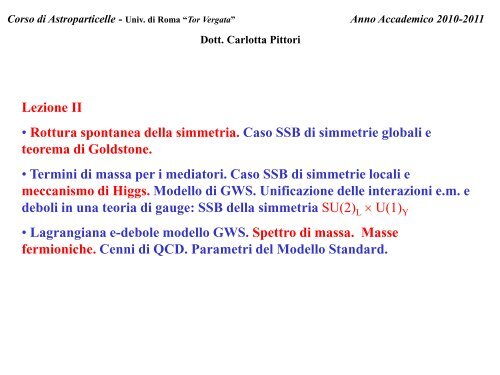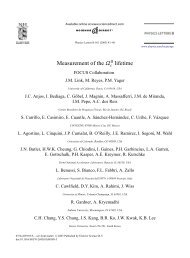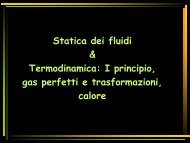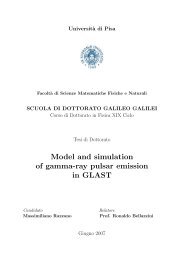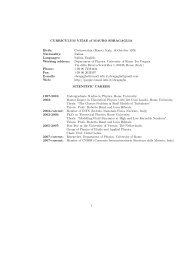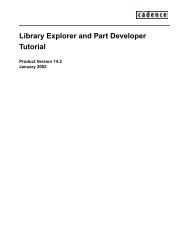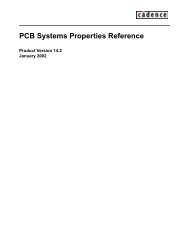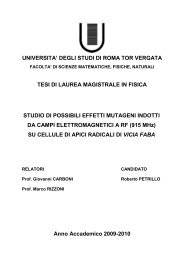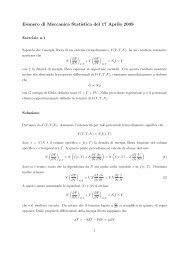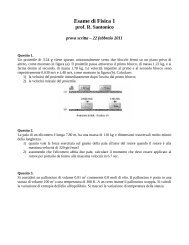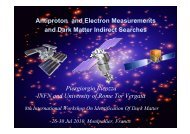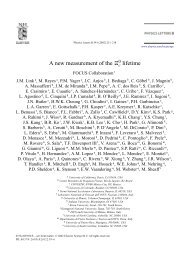Lezione II • Rottura spontanea della simmetria. Caso SSB di ...
Lezione II • Rottura spontanea della simmetria. Caso SSB di ...
Lezione II • Rottura spontanea della simmetria. Caso SSB di ...
You also want an ePaper? Increase the reach of your titles
YUMPU automatically turns print PDFs into web optimized ePapers that Google loves.
Corso <strong>di</strong> Astroparticelle - Univ. <strong>di</strong> Roma “Tor Vergata” Anno Accademico 2010-2011<br />
Dott. Carlotta Pittori<br />
<strong>Lezione</strong> <strong>II</strong><br />
• <strong>Rottura</strong> <strong>spontanea</strong> <strong>della</strong> <strong>simmetria</strong>. <strong>Caso</strong> <strong>SSB</strong> <strong>di</strong> simmetrie globali e<br />
teorema <strong>di</strong> Goldstone.<br />
• Termini <strong>di</strong> massa per i me<strong>di</strong>atori. <strong>Caso</strong> <strong>SSB</strong> <strong>di</strong> simmetrie locali e<br />
meccanismo <strong>di</strong> Higgs. Modello <strong>di</strong> GWS. Unificazione delle interazioni e.m. e<br />
deboli in una teoria <strong>di</strong> gauge: <strong>SSB</strong> <strong>della</strong> <strong>simmetria</strong> SU(2) L U(1) Y<br />
• Lagrangiana e-debole modello GWS. Spettro <strong>di</strong> massa. Masse<br />
fermioniche. Cenni <strong>di</strong> QCD. Parametri del Modello Standard.
RIASSUNTO LEZIONE I:<br />
(spesso =0 ovvero<br />
L stessa invariante)<br />
Corrente conservata e cost. moto<br />
Simmetrie locali <strong>di</strong> gauge Campi vettoriali (campi <strong>di</strong> gauge) a massa nulla.<br />
Forma dell’interazione ra<strong>di</strong>azione- materia completamente specificata.<br />
Ma qual’ è l’origine delle masse dei me<strong>di</strong>atori?
<strong>Rottura</strong> Spontanea <strong>della</strong> Simmetria<br />
<strong>SSB</strong> = Spontaneous Symmetry Breacking
in termini <strong>di</strong> 1 e 2 il potenziale è:<br />
per la stabilità <strong>della</strong> teoria<br />
deve essere positivo<br />
identificato
Per trovare lo spettro delle “particelle” associate<br />
al campo dobbiamo espandere L intorno al minimo<br />
e stu<strong>di</strong>arne la parte quadratica.
*suggerita dall’evidenza sperimentale<br />
*
Sostituendo l’espressione che <strong>di</strong>agonalizza il t. quadratico, si trova:<br />
Parte <strong>di</strong> interazione <strong>della</strong> Lagrangiana Elettrodebole<br />
Previsione <strong>della</strong> teoria: correnti deboli neutre!
Fluttuazioni intorno allo stato <strong>di</strong> vuoto < 0 >=v corrispondono a emissione e<br />
assorbimento <strong>di</strong> bosoni <strong>di</strong> Higgs<br />
La massa del fotone rimane zero!
Trascurando le masse fermioniche, L ew <strong>di</strong>pende da 4 parametri<br />
in<strong>di</strong>pendenti:<br />
2 costanti <strong>di</strong> accoppiamento:<br />
(se si considerano solo le prime due<br />
generazioni solo 1 parametro: angolo <strong>di</strong><br />
Cabibbo sin c )<br />
Usando la relazione:
LE MASSE FERMIONICHE<br />
Consideriamo un generico fermione f (può essere leptone o quark).<br />
Un termine <strong>di</strong> massa nella Lagrangiana <strong>di</strong> Dirac libera appare nella<br />
forma:<br />
(non abbiamo ( e ) R perchè<br />
qui il è supposto a massa<br />
nulla ed elicità definita)
nuovo accoppiamento arbitrario!
ora per la rottura <strong>spontanea</strong> <strong>della</strong> <strong>simmetria</strong> si ha al solito:<br />
(ricor<strong>di</strong>amo che<br />
v=2M w /g )<br />
2<br />
(m e M W )
(NON NE PARLIAMO QUI)
Interazioni forti e Cromo<strong>di</strong>namica Quantistica<br />
(CENNI <strong>di</strong> QCD)<br />
Da esperimenti <strong>di</strong> <strong>di</strong>ffusione profondamente anelastica (DIS = Deep Inelastic<br />
Scattering) <strong>di</strong> elettroni su nucleoni (eN), <strong>di</strong> neutrini su nucleoni ( N) e dalla<br />
analisi <strong>della</strong>
Lo spazio del colore può essere preso come<br />
rappresentazione <strong>di</strong> un nuovo gruppo <strong>di</strong> <strong>simmetria</strong> SU(3)<br />
per i quark<br />
La Lagrangiana delle interazioni forti per quark “liberi” si scrive:<br />
somma su tutti i flavour q<br />
(u, d, c, s, t, b)
QCD aggiunge un solo param.: g s<br />
Le 3 interazioni fondamentali sono tutte descritte<br />
da teorie <strong>di</strong> gauge:<br />
Dipende in tot. da 18 parametri: 3 cost. <strong>di</strong> acc., 2 parametri del<br />
pot. <strong>di</strong> Higgs, 9 masse fermioniche (3 leptoni, 6 quarks, lim m =0),<br />
4 CKM (3 angoli e una fase) (se m 0 altri 9 parametri)
Divergenze e Rinormalizzazione<br />
(cenni)
Grafici <strong>di</strong> loop<br />
Uno dei successi <strong>della</strong> fisica teorica delle particelle<br />
elementari è stato lo sviluppo <strong>della</strong>:<br />
Ad esempio:<br />
• momento magnetico anomalo dell’elettrone e del muone<br />
• livelli energetici dell’atomo <strong>di</strong> idrogeno (Lamb Shift)
arXiv:hep-ex/0407040: The Experimental Status of the Standard Electroweak Model at the End of the LEP-SLC Era
Oltre il Modello Standard<br />
Nessun risultato sperimentale è in <strong>di</strong>saccordo con il Modello Standard.<br />
Ma teoria non “completa” in quanto non risponde alle seguenti domande:<br />
• Perché 18 parametri liberi? Possibile esistenza <strong>di</strong> una teoria<br />
fondamentale (true theory of everything =TOE) che <strong>di</strong>penda da un solo<br />
parametro (o nessun parametro) libero?<br />
• Qual’è la vera natura <strong>della</strong> rottura <strong>spontanea</strong> <strong>della</strong> <strong>simmetria</strong><br />
elettrodebole? Il meccanismo <strong>di</strong> Higgs funziona, ma l’introduzione <strong>di</strong> un<br />
campo scalare non ancora osservato sembra arbitraria. L’Higgs se<br />
esiste è una particella fondamentale o composita?<br />
• Qual’è la natura <strong>della</strong> violazione <strong>di</strong> CP?<br />
From Stephen Godfrey list of questions:<br />
1. Why are there three generations?<br />
2. Why do the fermion masses take the values they do?<br />
3. Why the Higgs mechanism and is the Higgs mechanism even correct?<br />
4. What is the connection between the quarks and leptons?<br />
5. Why does electric charge appear to be quantized in units of ?<br />
6. What is responsible for electroweak symmetry breaking?<br />
7. What is the origin of CP violation?<br />
8. How does gravity fit in?
Principalmente 4 approcci possibili alla fisica oltre il<br />
Modello Standard, che si prefiggono <strong>di</strong> spiegare la “nuova<br />
fisica” che si dovrebbe manifestare sperimentalmente a<br />
scale <strong>di</strong> energia superiori al TeV<br />
• extended gauge theories,<br />
• technicolour,<br />
• composite models,<br />
• supersymmetry ( Lionetto)<br />
• Nelle teorie <strong>di</strong> Grande Unificazione (GUTS) ci si<br />
aspetta che il bosone <strong>di</strong> Higgs abbia una massa dello<br />
stesso or<strong>di</strong>ne <strong>della</strong> scala <strong>di</strong> unificazione.<br />
• Una previsione importante <strong>della</strong> SUSY è che esista<br />
uno scalare <strong>di</strong> Higgs relativamente leggero<br />
unificazione a energie presto raggiungibili<br />
fenomenologicamente con i nuovi acceleratori.


